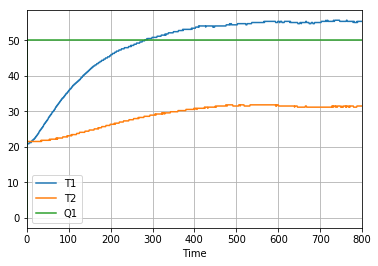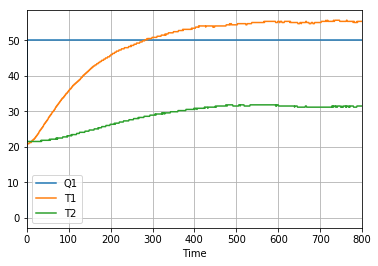3.1. Fitting Step Test Data to Empirical Models#
3.1.1. Read the Data File#
%matplotlib inline
import pandas as pd
df = pd.read_csv('data/step-test-data.csv')
df = df.set_index('Time')
df.plot(grid=True)
<matplotlib.axes._subplots.AxesSubplot at 0x11efd7350>

3.1.2. Parameter Estimation#
3.1.2.1. Fitting the Step Change Data to a First Order Model#
For a first-order linear system initially at steady-state, the response to a step input change at \(t=0\) is given by
where \(\Delta U\) is the magnitude of the step change. Converting to notation used for the temperature control lab where \(y(t) = T_1(t)\) and \(\Delta U = \Delta Q_1\)
the following cells provide initial estimates for the steady state gain \(K_1\) and time constant \(\tau_1\).
3.1.2.2. Reading Saved Data#
df[['Q1','T1','T2']].plot(grid=True)
<matplotlib.axes._subplots.AxesSubplot at 0x11f23f2d0>

3.1.2.3. Estimating Gain and Time Constant#
In the limit \(t\rightarrow\infty\) the first order model becomes
which provides an method for estimating \(K_1\)
These calculations are performed below where we use the first and last measurements of \(T_1\) as estimates of \(T_1(0)\) and \(T_1(\infty)\), respectively.
T1 = df['T1']
Q1 = df['Q1']
DeltaT1 = max(T1) - min(T1)
DeltaQ1 = Q1.mean()
K1 = DeltaT1/DeltaQ1
print("K1 is approximately", K1)
K1 is approximately 0.6968700000000001
# find when the increase in T1 gets larger than 63.2% of the final increase
i = (T1 - T1.min()) > 0.632*(T1.max()-T1.min())
tau1 = T1.index[i].min()
print("tau1 is approximately", tau1, "seconds")
tau1 is approximately 163.0 seconds
import matplotlib.pyplot as plt
import numpy as np
exp = np.exp
t = df.index
T1_est = T1.min() + K1*(1 - exp(-t/tau1))*DeltaQ1
plt.figure(figsize=(10,5))
ax = plt.subplot(2,1,1)
df['T1'].plot(ax = ax, grid=True)
plt.plot(t,T1_est)
plt.title('Step Test Data Compared to Model')
plt.subplot(2,1,2)
plt.plot(t,T1_est-T1)
plt.grid()
plt.title('Residual Error')
Text(0.5,1,'Residual Error')

A first order model captures certain features, and provides a reasonably good result as the system approaches a new steady-state. The problem, however, is that for control we need a good model during initial transient. This is where the first-order model breaks down and predicts a qualitatively different response from what we observe.
3.1.3. First Order plus Dead Time#
%matplotlib inline
import matplotlib.pyplot as plt
import numpy as np
import pandas as pd
from ipywidgets import interact
df = pd.read_csv('data/step-test-data.csv')
df = df.set_index('Time')
T1 = df['T1']
Q1 = df['Q1']
t = df.index
DeltaT1 = max(T1) - min(T1)
DeltaQ1 = Q1.mean()
K1 = DeltaT1/DeltaQ1
i = (T1 - T1.min()) > 0.632*(T1.max()-T1.min())
tau1 = T1.index[i].min()
def fopdt(K=K1, tau=tau1, theta=0, T10=T1.min()):
def Q1(t):
return 0 if t < 0 else DeltaQ1
Q1vec = np.vectorize(Q1)
T1_fopdt = T10 + K*(1-np.exp(-(t-theta)/tau))*Q1vec(t-theta)
plt.figure(figsize=(10,5))
plt.subplot(2,1,1)
plt.plot(t,T1_fopdt)
plt.plot(t,df['T1'])
plt.subplot(2,1,2)
plt.plot(t,T1_fopdt - T1)
plt.show()
interact(fopdt,K=(0,1,.001),tau=(50,200,.5),theta=(0,50,.5),T10=(15,25,.1))
<function __main__.fopdt(K=0.6968700000000001, tau=163.0, theta=0, T10=20.9)>
3.1.4. Second Order#
SEMD Eqn. 5-48
%matplotlib inline
import matplotlib.pyplot as plt
import numpy as np
import pandas as pd
from ipywidgets import interact
df = pd.read_csv('data/step-test-data.csv')
df = df.set_index('Time')
T1 = df['T1']
Q1 = df['Q1']
t = df.index
DeltaT1 = max(T1) - min(T1)
DeltaQ1 = Q1.mean()
K1 = DeltaT1/DeltaQ1
i = (T1 - T1.min()) > 0.632*(T1.max()-T1.min())
tau1 = T1.index[i].min()
def secondorder(K=K1, tau1=tau1, tau2=40, T10=T1.min()):
def Qscalar(t):
return 0 if t < 0 else DeltaQ1
Q = np.vectorize(Qscalar)
exp = np.exp
T = T10 + K*(1 - (tau1*exp(-t/tau1) - tau2*exp(-t/tau2))/(tau1-tau2))*Q(t)
plt.subplot(2,1,1)
plt.plot(t,T)
plt.plot(t,df['T1'])
plt.subplot(2,1,2)
plt.plot(t,T1 - T)
plt.show()
interact(secondorder,K=(0,1,.001),tau1=(1,200,.1),tau2=(0,200,.1),T10=(15,25,.1))
<function __main__.secondorder(K=0.6968700000000001, tau1=163.0, tau2=40, T10=20.9)>
3.1.5. Fitting a Second Order Model by Least Squares#
from scipy.optimize import least_squares
import numpy as np
Qmax = 50
def f(x):
K,tau1,tau2,T10 = x
t = df.index
exp = np.exp
Tpred = T10 + K*(1 - (tau1*exp(-t/tau1) - tau2*exp(-t/tau2))/(tau1-tau2))*Qmax
resid = df['T1'] - Tpred
return resid
ic = [0.86,40,130,20]
r = least_squares(f,ic,bounds=(0,np.inf))
r.x
array([ 0.69537389, 19.68872647, 141.40950924, 20.91093839])

